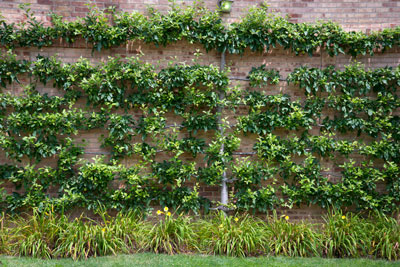Vines, Espaliers and Other Flat Plants
There are times when you’d like to have the height of a tall shrub, but when you don’t have very much horizontal space in your garden. Driveways that run alongside the garage are one common example. Often, there are only 10 or 12 inches of exposed ground, yet the wall extends 20 feet to the eaves. You can face the same dilemma along a front sidewalk at your front door or out back, by the fence. You have more needs than you have space for them. What can a poor gardener do?
Vines are one good possibility. If it’s a stone or brick wall, choose a clinging vine such as Boston ivy or Virginia creeper for a sunny site or English ivy for the shade. Climbing fig ivy does well in-between, with morning sun and protection from the hottest afternoon sun. It’s one of the most popular clinging vines from Central Texas and southward, but it will suffer freeze damage below the mid-20s.
If you have a wooden surface, you’ll need to use a twining or sprawling vine. More explanation is in order. If it’s the side of your house, you’ll need to build some type of trellis on which the vine can climb. The pre-fab versions work well, but a sturdier structure built from 2 x 2 decay-resistant lumber would be much better. Stand it out from the wall by several inches for good air circulation and consider building it with hinges at its base to allow you to lay it over when it comes time to repaint. You’ll be able to grow climbing roses by tying them to the support, or you can choose twining vines like wisteria, Madame Galen trumpetcreeper, Carolina jessamine, Confederate star jasmine and honeysuckle. You could even use annual vines such as morning glories, hyacinth bean, moon vine and cypress vine.
You can use the same stable of twining vines to grow up and over a wood fence in the alleyway. There’s a trick, however, to getting the best look from this type of planting: let the stems be in the alley, not on the house side of the fence. The prettiest part of any vine will be its new growth and flowers, and you’ll be happiest if you let the vine grow up and tumble over, into your yard. That way you’ve added greenery to two sides of the very same vertical surface, yet you’ve stolen almost no ground space from either area of your landscape. Install a simple drip irrigation line in the alley to make watering easy.

Even fruit trees can be trained to grow flat against walls.
Espaliers are essentially shrubs (and occasionally trees) that have been trained to grow two-dimensionally, flat against their supports. You’ll want a supple-stemmed plant such as pyracantha, Hollywood twisted juniper or willowleaf holly as your star. Train it to grow flat against the wall. Have an idea of the natural-looking form you want it to take (formal espaliers are pretty restless in the design). Train each twig to conform to that predisposed pattern. Use lead anchors and plant ties to secure them in place, and fill out the bottom parts of the espalier before you move up the stems. It gains you several years’ training if you’ll buy a plant that has already been shaped and sculpted at the nursery.
You can actually combine these two techniques of vines and espaliers by training English ivy, purple wintercreeper euonymus or some other vine to take on a pre-determined pattern on the side of your house. It may help to have a series of single wires to which you can train the vine. Lead masonry nails are a good way of securing the wire.
Finally, columnar plants offer yet another option in narrow-space landscaping. They belong at the end of our list, as they’re the least natural-looking solutions and the most difficult to work into a soft, pleasing design. Scarlet’s Peak yaupon holly grows to 8 or 10 feet tall and only 2 feet wide. Columnar junipers and Italian cypress are boldly upright, many growing to 20 feet and taller. In fact, they can quickly become distracting. Less formal selections such as Spartan juniper are a better compromise. Japanese yew podocarpus, similarly, grows decidedly upright, but it’s less rigid and it doesn’t look like an exclamation point in the landscape.
Narrow areas are a challenge to be sure, but much of Texas gardening is. Somehow, we figure ways to survive.

